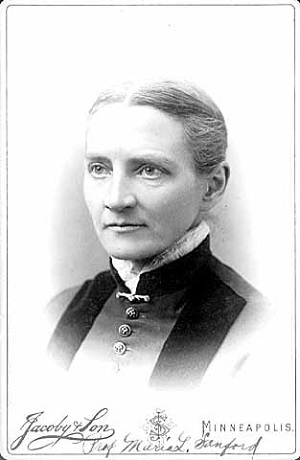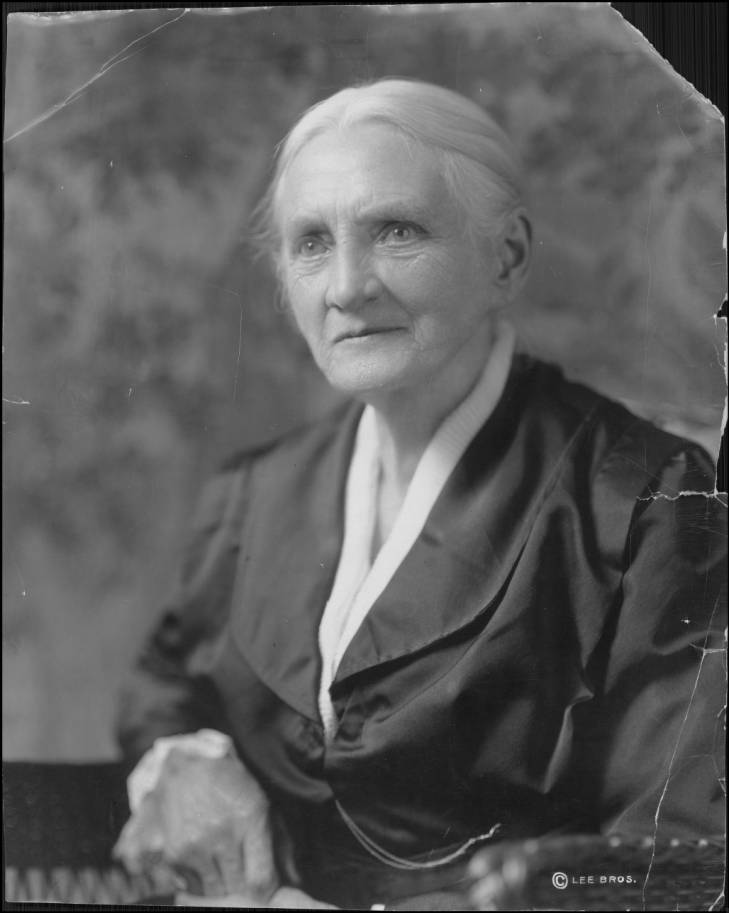The Best Loved Woman of the North Star State
 Sunday, August 23, 2020 at 4:17PM |
Sunday, August 23, 2020 at 4:17PM |  Michael Rainville Jr |
Michael Rainville Jr | Article by Michael Rainville, Jr.
 1880 portrait of Maria SanfordFor thousands of years teachers have been passing on knowledge and inspiring students to achieve their dreams. Aristotle, Booker T. Washington, Maria Montessori and Eleanor Roosevelt have impacted thousands of eager learners as they all dedicated their lives to teaching. Another name to put on this list of legendary teachers is Maria Sanford, one of the first female professors in America and a very important woman in Minnesota and United States History.
1880 portrait of Maria SanfordFor thousands of years teachers have been passing on knowledge and inspiring students to achieve their dreams. Aristotle, Booker T. Washington, Maria Montessori and Eleanor Roosevelt have impacted thousands of eager learners as they all dedicated their lives to teaching. Another name to put on this list of legendary teachers is Maria Sanford, one of the first female professors in America and a very important woman in Minnesota and United States History.
Maria Louise Sanford was born in 1836 in Saybrook, Connecticut and tried to learn everything she could as a child. At the age of fifteen, she used her dowry to pay tuition to attend the New Britain Normal School. Four years later in 1855, she graduated with honors. During the next decade and a half, she taught at various schools until she was appointed as the principal for an academy in Unionville, Pennsylvania in 1869. Later that same year, Swarthmore College, also in Pennsylvania, hired her as a history professor.
 Maria Sanford portrait, 1918During her time at Swarthmore, she began to master the craft of lecturing, traveling from town to town, speaking to educators about raising moral and utilizing aesthetics to create a welcoming and comfortable atmosphere in the classroom. After ten years at Swarthmore, she retired to focus on her lecturing career. In 1880, the president of the University of Minnesota, Dr. William Watts Folwell, took note of her public speaking ability and invited her to interview for a new French language professor position. While Maria Sanford did not have an advanced degree and did not speak French, Dr. Folwell was still very impressed with her knowledge and talent and hired her as a professor in the English Department. This made her the first woman to be a professor at the University. During her tenure, she would teach rhetoric, elocution, literature, and art history. Later in Dr. Folwell’s career, he stated that hiring Maria Sanford was his proudest accomplishment.
Maria Sanford portrait, 1918During her time at Swarthmore, she began to master the craft of lecturing, traveling from town to town, speaking to educators about raising moral and utilizing aesthetics to create a welcoming and comfortable atmosphere in the classroom. After ten years at Swarthmore, she retired to focus on her lecturing career. In 1880, the president of the University of Minnesota, Dr. William Watts Folwell, took note of her public speaking ability and invited her to interview for a new French language professor position. While Maria Sanford did not have an advanced degree and did not speak French, Dr. Folwell was still very impressed with her knowledge and talent and hired her as a professor in the English Department. This made her the first woman to be a professor at the University. During her tenure, she would teach rhetoric, elocution, literature, and art history. Later in Dr. Folwell’s career, he stated that hiring Maria Sanford was his proudest accomplishment.
She was immediately a favorite among the University students, and even though her courses included a high workload, her pupils were always dedicated and enthusiastic. While she was one of the top professors, she was still making less than her male counterparts. In order to bring more income in and to expand her student’s knowledge, she began renting books to students and offering “sunrise courses” to those who were interested. A win-win. In her spare time, she would also tour the state and nation giving lectures. A few professors at the University were not fond of her side-jobs and frequently complained to University officials. The complaints were never addressed, as she was doing an amazing job as a professor and also gave the University credibility with her lecturing tours.
 Maria Sanford statue in Statuary Hall in D.C.During Maria Sanford’s state tours, she would speak about Minnesota’s nature and how it is important to preserve it. Because of her efforts, along with historian Jacob Brower’s, Itasca State Park was founded in 1891 and the headwaters of the Mississippi River would be saved for generations to come.
Maria Sanford statue in Statuary Hall in D.C.During Maria Sanford’s state tours, she would speak about Minnesota’s nature and how it is important to preserve it. Because of her efforts, along with historian Jacob Brower’s, Itasca State Park was founded in 1891 and the headwaters of the Mississippi River would be saved for generations to come.
She frequently hosted student social events in her home in SE Minneapolis, and because of her popularity, she placed third in the Minneapolis Journal’s favorite-teacher contest. Her students could not believe she didn’t win, so they raised enough money to buy her the grand prize, a trip to Europe! Because of her popularity with her students and local officials, she was often referred to as the “the best loved woman of the North Star State.”
At the age of seventy-two, she retired from the University of Minnesota in 1909 and was invited to be the commencement speaker for that year’s ceremony, where she would also be named professor emeritus of rhetoric. This made her the first female to give a commencement speech at any major university. During her tenure, she saw the University of Minnesota grow from 300 students to over 4,800
She was still quite active in her post-retirement life by continuing to tour across the United States lecturing about environmental preservation, education, healthcare and temperance, and promoting women’s rights and equal opportunities for people of color in the education world. During World War I, she continued her tours, this time sticking to more patriotic subjects, such as her famous speech An Apostrophe to the Flag.
On April 21st, 1920, after giving a speech to the Daughters of the American Revolution in Washington D.C., Maria Sanford passed away in her sleep at the age of eighty-three. However, her legacy continues on to this day in many forms. A year after she retired, the University of Minnesota opened up Sanford Hall, the first female housing on campus. She is also the namesake of Sanford Middle School in South Minneapolis, the Minneapolis chapter of the Daughters of the American Revolution, the Maria Sanford Chapter, was named in her honor in 1923, she was chosen to represent Minnesota in Washington D.C.’s Statuary Hall in 1958, and the Hennepin History Museum has one of her traveling lecture podiums in their collection. She truly was, and still is, a role model everyone can look up to.
- - - - - - - - - - - - - - - - - - - - - - - - - -
 About Michael Rainville, Jr.
About Michael Rainville, Jr.
A 6th generation Minneapolitan, Michael Rainville Jr. received his B.A. in History from the University of St. Thomas, and is currently enrolled in their M.A. in Art History and Certificate in Museum Studies programs. Michael is also a historic interpreter and guide at Historic Fort Snelling at Bdote and a lead guide at Mobile Entertainment LLC, giving Segway tours of the Minneapolis riverfront for 7+ years. Contact: mrainvillejr@comcast.net. Click here for an interactive map of Michael's past articles.
